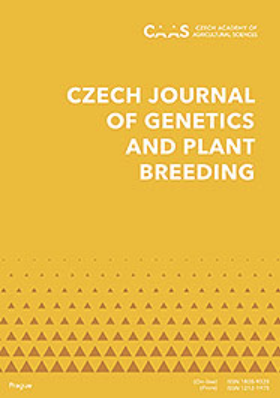QTL mapping of adult plant resistance to stripe rust in the Fundulea 900 × Thatcher RIL population
IF 1.8
4区 农林科学
Q3 AGRONOMY
引用次数: 7
Abstract
Wheat stripe rust, caused by Puccinia striiformis Westend. f.sp. tritici Eriks (Pst), is one of the most important diseases of bread wheat worldwide. Breeding resistant wheat cultivars is the most economical, effective and environmentally friendly way for controlling wheat stripe rust in China. The Romanian wheat line Fundulea 900 showed good resistance to wheat stripe rust at the adult stage. The present study aimed to map the quantitative trait loci (QTLs) for stripe rust resistance in 176 F2:6 recombinant inbred lines (RIL) derived from the cross of Fundulea 900 × Thatcher. The RIL population was phenotyped for stripe rust (YR) severity at Mianyang in the Sichuan province and Baoding in the Hebei province in the 2016/2017 and 2017/2018 cropping seasons. SSR markers combined with a preferred screened group (PSG) analysis were used to identify the QTLs for stripe rust in the population. Three QTLs for stripe rust resistance were mapped on chromosomes 1AL, 7BL and 7DS, respectively. All three QTLs originated from Fundulea 900 and were detected in all the environments. The QTL on 7DS was provided by the known resistance gene Yr18/Lr34. The two QTLs on chromosomes 1AL and 7BL were explained by 9.2 to 21.5% and 5.1 to 10.1% of the phenotypic variance, respectively and might be new QTLs. The QTLs identified in the study and their closely linked markers can be used for marker-assisted selection (MAS) in wheat breeding programmes.Fundulea 900×Thatcher群体成株抗条锈病QTL定位
小麦条锈病,由条纹锈菌引起。小麦疫病是世界范围内最重要的面包小麦病害之一。选育抗病小麦品种是我国防治小麦条锈病最经济、最有效、最环保的途径。罗马尼亚小麦品系Fundulea 900在小麦条锈病成虫期表现出良好的抗性。本研究旨在对由Fundulea 900×Thatcher杂交获得的176个F2:6重组自交系(RIL)的抗条锈病数量性状位点(QTL)进行定位。2016/2017年和2017/2018年种植季节,四川绵阳和河北保定的RIL群体对条锈病(YR)严重程度进行了表型分析。采用SSR标记和优选筛选群(PSG)分析相结合的方法鉴定群体中条锈病的QTL。3个抗条锈病QTL分别定位在染色体1AL、7BL和7DS上。三个QTL均来源于Fundulea 900,在所有环境中均被检测到。7DS上的QTL由已知的抗性基因Yr18/Lr34提供。1AL和7BL染色体上的两个QTL的表型方差分别为9.2%至21.5%和5.1%至10.1%,可能是新的QTL。研究中鉴定的QTL及其紧密连锁的标记可用于小麦育种计划中的标记辅助选择(MAS)。
本文章由计算机程序翻译,如有差异,请以英文原文为准。
求助全文
约1分钟内获得全文
求助全文
来源期刊

Czech Journal of Genetics and Plant Breeding
Agricultural and Biological Sciences-Plant Science
CiteScore
2.20
自引率
0.00%
发文量
25
审稿时长
>12 weeks
期刊介绍:
Original scientific papers, critical reviews articles and short communications from the field of theoretical and applied plant genetics, plant biotechnology and plant breeding. Papers are published in English.
 求助内容:
求助内容: 应助结果提醒方式:
应助结果提醒方式:


